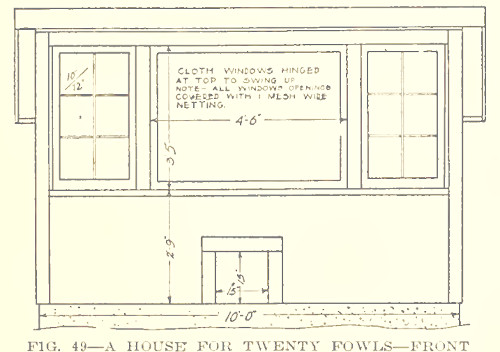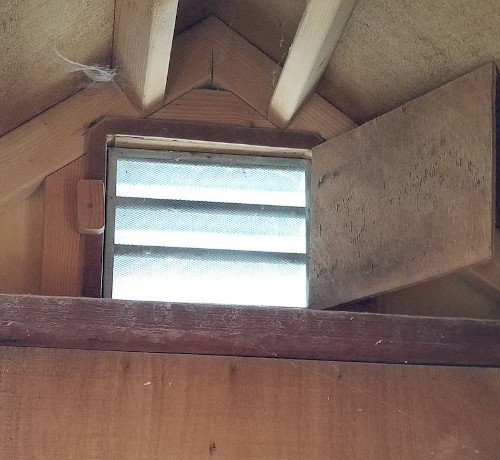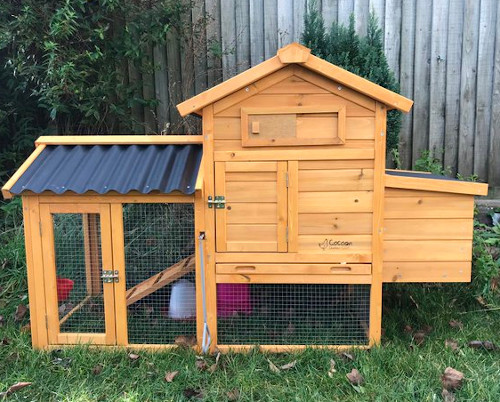Chicken coop ventilation. Why its so important and how to do it right.

Why it's crucial to ventilate a chicken coop.
I chose this header image as it demonstrates the amount of moisture leaving the chicken coop overnight and freezing outside of the vent. Even a handful of chickens generate a lot of moisture during the night from their breathing and pooing.
Mature chickens need an ideal indoor ambient air temperature of between 20 and 27 degrees C. This is the temperature range at which they feel most comfortable.
You need to ventilate a chicken coop to allow the heat, carbon dioxide, moisture and ammonia fumes to flow out and to allow fresh air in. Chickens are very good in the cold but will quickly get ill an die if allowed to live in damp and unventilated conditions.
In commercial poultry operations a minimum airflow of 4 cubic metres of air per kg of live weight per hour is the lowest acceptable standard for ventilation.
A windbreak of some kind on the cold side of the building is a decided advantage. A wall, an evergreen hedge, a grove, or other buildings, will protect the poultry house, and, perhaps, also a portion of the runs, with benefit to the poultry.
Below: Here is a coop plan for 20 chickens from an old poultry book that recommends a cloth and netting panel in the front of the coop 4 foot 6 long and 3 foot 6 high.

In that the family flock may range in size from half a dozen to fifty or seventy five birds, the size of the building, and even its style, must vary to suit one's needs. A small coop, almost square, may house your flock of eight or ten, but the larger flock requires a house longer and higher, with more ample ventilation.
A large building with no direct ventilation is not as healthy for chickens as a small house that admits just the right amount of fresh air. Size is no guarantee of quality.
What are chicken coop vents?
Chicken coop vents are holes in the walls of the chickens coop that are covered with a hardware cloth or weld-mesh to keep snakes and vermin out but let fresh air in to the bottom of the coop and warm stale air out of the top of the the hen house.
They are usually sited in groups of small vents or pairs of large vents, two high up and two low down and face away from any prevailing weather so that air moves gently through the coop without causing a draught.
There are two basic types of ventilation for chicken coops:
1. Passive ventilation. this is where the air is allowed to flow naturally through the hen house with no outside assistance although you can get roof mounted units that are driven by the wind.
2. Active or forced air ventilation. This is where you use electricity to power some sort of fan which can become expensive but there are some solar powered units on the market.
Vents should be easy to see so as you can check that snakes and rats are not getting in to the coop.
If you live in a very hot part of the world you may have to install a fan in your coop.
Most of the coops I see have too little ventilation.
Do all chicken coops need vents?
Yes, all chickens coops need vents of some kind, even in the depths of winter. In fact more so in the depths of winter as dampness is harder to dry out if the coop becomes wet.
Vents prevent the build up of excess moisture, heat, carbon dioxide from respiration and smell.
High relative humidity in cold environments actually increases the chickens chances of becoming sick and suffering from frostbite.
Below: A large mesh covered vent in the front of a coop.

They will also need to be cleaned and dusted to remover and blockages so as they work effectively all year.
How are coop vents made?
The vents themselves can be anything from a series of small holes to a large opening covered with a grill or mesh. You can either drill your own or cut a square out and do it that way.
Below: A large mesh vent with a door panel to close if necessary.

My preference is for multiple small holes in both the top and bottom of the same side of the coop. A few of my coops have flat rooves which I have tilted to provide a triangular gap all at either end.
Where I live we have weather and wind that tends to always come from the same direction so I just avoid putting vents in that side of the coop.
You can make larger vents covered by a flap for adjusting the airflow on warmer days.
How much ventilation do you need in a chicken coop?
More than you think. Too much is always better than too little.
I drill holes in the wood of my hen houses and cover them with weld-mesh to help keep the nasties out. I start with a dozen one inch holes in the apex of the roof spaced and inch or two apart and then add two holes per chicken at the base of the shed on the same side.
Below: These vents, seen here closed, are way too small.

They need to be on the same side as it would create a draft across the coop if they were opposite each other. The idea is to have air flow and not wind.
I use this method to test the ventilation Vs draft in my chicken coops:
Hold a lit match or cigarette lighter, if the air blows the flame out there is too much draught.
When the flame wobbles and dances about but does not go out then you have the air flow just right.
If the air does not move the flame at all you may need to look into increasing the air flow or adding another vent.
Another excellent way to know if your coop has enough ventilation is to smell it as you open the door in the morning. If you are greeted with the smell of ammonia then you need to increase ventilation.
Do you still need ventilation in winter?
You still need coop ventilation in winter. Even more so as problems with moisture and odour build-up are harder to rectify at this time of year.
Ridge vents in the chicken coop need to be open all year.
Can I use chicken coop ventilation fans?
If you have an electric supply to your coop and you want to fit a fan to extract air from your chickens coop then it is perfectly acceptable and may even be a must have if you live in a very hot part of the world.
I would choose a quiet one with a large fan that turns more slowly. You can fit it with a timer so it turns of in the evening.
The grills will clog very quickly with feathers, dust and dander and so will need to be cleaned more regularly than natural vents.
Does the air need to move in a particular direction through the coop?
I have noticed that my chickens will normally sleep facing into the fresh air. This seems to be how chickens sand indeed all wild birds roost, facing into any wind and weather.
How do you ventilate a chicken coop?
The best way to ventilate a chicken coop is to have adjustable flaps or sliding covers that you can open and close to set a flow of air through the coop.
A coop should be tight enough to keep the wind out but ventilated near the top to let the ammonia fumes and carbon dioxide out. A nice bedding of straw or wood shavings will help retain warmth in the bottom of a chicken coop.
Chickens' do not feel the cold as they have an insulating layer of warm air between their feathers and their body, trapped in their down.
One of the items I have taken to using to ventilate a chicken a coop is the automatic heat activated green house window openers. These are a cheap and simple solution that open a window or vent automatically as the temperature rises and closes the vent again as it cools.
How do you ventilate without drafts?
For good wintertime ventilation, put your vents high up on the walls tucked up below a roof overhang for some protection and place the low down ones on the same side of the hen house.
Make your coop vents adjustable. You do need low down as well as high up vents, otherwise air will not flow properly. Drafts are avoided by having all the vents on the same side of the coop.
Such a building must offer no hospitality to other than poultry life, and it must be constructed in line with the economic value of its residents.
In short, the chicken coop must be so constructed as to guard against drafts, dampness, disease, and vermin, to insure a profitable result. A maximum of comfort with a minimum of risk insures healthy poultry.
Do more windows equal better ventilation?
They can do, but you shouldn't plan on using windows for light and ventilation. You will still need ventilation in the depths of winter when it's cold and the windows are shut.
Chickens have a delicate respiratory system and so it’s very important that your coop has proper ventilation to avoid respiratory diseases in your chickens.
Can you buy chicken coop vents?
Most small mesh covered vents in hardware stores are suitable for use in the hen house.
